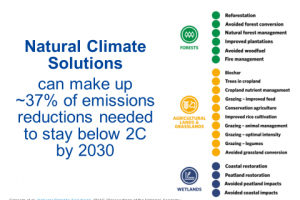
Stabilizing the Climate by 2030 through Radiative Forcing Management
As the pace of climate change is accelerating, so too is our understanding of the factors driving this change. At the core of problem are the emissions and other human activities that are changing the heat balance of the earth, measured as “radiative forcing.” We now know it is possible to get ahead of dangerous climate disruption and temperature rise by managing this excess heat. Every company, organization and government jurisdiction has a vital role to play to effectively address the near-term climate crisis before 2030, and contribute to a sustainable climate future.
For our other solutions, please click https://www.envirolink.me/solutions/
Radiative forcing management (RFM) is a direct outgrowth of internationally recognized IPCC consensus science. It provides the most comprehensive, scientifically robust way to calculate climate footprints, determine progress toward and verify true climate neutrality, and establish offsets. It also substantially broadens the range of climate mitigation projects that can be verified, providing far greater options for organizations seeking to reduce their climate footprint in the most cost-effective manner, while making a meaningful contribution to global climate stabilization.
Service Offering
- Radiative Forcing Management (RFM) provides the tools companies, organizations and government jurisdictions need to have the greatest positive impact on our climate. These tools include far more accurate climate footprints than ever before, greater clarity about the scale of solutions required to achieve climate stability before critical temperature thresholds are crossed, and a substantially increased range of options for achieving climate neutrality.
- Climate Footprint Verification – Traditional carbon footprints reflect only a small part of the climate change story. Stabilizing the climate in the critical near-term, and ultimately restoring the Earth to full climate health, requires a more complete understanding of the full range of factors contributing to the problem.
- Climate Footprint Consulting – Once your RF-based climate footprint is determined, it is possible to choose from a much wider range of effective mitigation opportunities, many of which can be far more cost-effective than previously available.
- Climate Mitigation Project Pre-Screening – Current, planned, and potential mitigation initiatives are evaluated based on a life-cycle assessment framework to identify potential co-benefits, as well as adverse trade-offs, to the climate, environment and human health. In addition, initiatives are analyzed for technological feasibility and cost.
- Climate Impact Reduction and Climate Neutrality Verification – Through the right combination of climate mitigation approaches, tailored to your organization’s unique profile or reflecting your sphere of influence, it is possible to reduce or entirely offset your climate footprint.
- Climate Offset Project Validation and Verification –RF accounting is used to evaluate the efficacy of climate mitigation projects that contribute measurably to global RFM goals, or to RF reduction in particularly vulnerable “high-risk” regions of the world.
Unique Features
- What makes RFM so powerful as a climate management tool is the truly comprehensive scope of radiative forcing accounting. This accounting is based on the very latest climate and environmental science, covering all emissions and factors contributing to climate change as well as determining co-benefits and adverse trade-offs. It covers:
- Annual greenhouse gases (GHG) – All of the GHG emissions historically addressed under standard carbon footprint and offset calculations and science-based targets (carbon dioxide, methane, nitrous oxide, sulfur hexafluoride, chlorofluorocarbons, and hydrofluorocarbons).
- Legacy GHGs – The accumulated build-up of CO2, methane and other GHG emissions from the past that are still retained in the atmosphere today, still influencing climate, and that will continue to linger for centuries.
- Corrected methane – Methane is 150-times more potent than carbon dioxide as a climate pollutant during its first year (as compared to normal value of 21-25 times more potent typically attributed to methane).
- All short-lived climate pollutants (SLCPs) – Especially black carbon and tropospherice ozone, which are 52,000-times and 32,000-times more potent respectively than carbon dioxide as climate pollutants while retained in the atmosphere.
- Net reduction of sulfates – Any reduction in such pollutants is included for a full accounting, since they artificially cool the planet even as they contribute to other dangerous human health and environmental conditions on the ground.
- Co-benefit and trade-off assessment – Many of the most effective climate mitigation strategies can have additional benefits for human health or the environment that should be accounted for. Such strategies can also have adverse impacts, or “trade-offs”, during their life-cycle that must be understood before these approaches are put into practice.
Benefits
- RFM provides numerous benefits to companies, organizations, and government jurisdictions, extending well beyond traditional climate services. Some of these benefits include:
- Providing new insights into an organization’s current and projected climate footprints, and the efficacy of current and potential science-based targets
- Demonstrating the extent to which current company or organization climate initiatives (e.g., zero waste, pollution prevention, operational efficiencies) may be yielding more climate benefit than they realize, along with co-benefits to human health and the environment
- Highlighting new opportunities to reduce an organization’s footprint or to become climate neutral
- Helping organizations reprioritize initiatives in order to steer investments and resources toward those projects that can produce the greatest climate benefit in the most cost-effective manner
- Reinforcing the role that technology and innovation will and must play to stabilize climate
- Strengthening broader organizational sustainability initiatives
- Identifying opportunities to reduce supply chain risks and reinforce climate resilience


